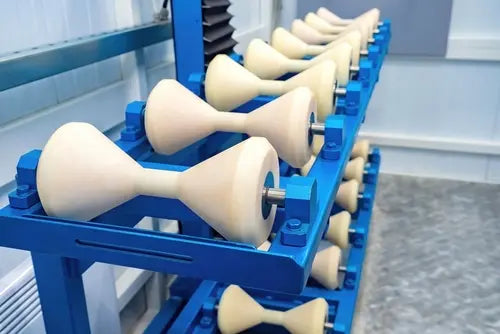Piping systems are the veins of any industrial facility, transporting everything from water and steam to gas and chemicals. One often-overlooked challenge in these systems is thermal expansion—the natural movement and elongation of pipes due to temperature changes. If not properly managed, it can lead to leaks, stress fractures, and even system failure. That’s where pipe roller supports come into play.
In this blog, we’ll explore what pipe roller supports are, how they work, their key benefits, and why they’re essential in any well-designed pipe support system.
What Is a Pipe Roller Support?
A pipe roller support is a type of pipe movement support that allows a pipe to move longitudinally—back and forth—while still being securely supported. Unlike rigid clamps or hangers that hold a pipe in place, pipe rollers accommodate expansion, contraction, and other natural movements due to thermal changes, vibrations, or shifting loads.
These supports typically include a rolling mechanism, such as wheels or curved surfaces, that sits beneath the pipe. The base of the support is fixed, while the pipe can move freely along the roller.
The Role of Pipe Roller Supports in Managing Thermal Expansion
Understanding Thermal Expansion in Piping Systems
Thermal expansion occurs when materials like metal expand and contract with temperature changes. In long pipeline runs, this can mean several inches of movement. Without the proper industrial piping supports, this movement puts stress on joints, welds, and equipment connections, which can lead to costly damage.
For example, a 100-foot steel pipe could expand nearly an inch for every 100°F temperature increase. Multiply that across an entire facility, and the importance of movement accommodation becomes clear.
How Pipe Roller Supports Help
Pipe rollers are designed specifically to manage this expansion and contraction. They:
-
Allow for axial pipe movement without introducing extra stress on the piping system.
-
Prevent pipe sagging or displacement during temperature fluctuations.
-
Protect connections, flanges, and valves from undue mechanical stress.
-
Improve system reliability and longevity by reducing wear and tear.
Types of Pipe Roller Supports
Choosing the right pipe roller stand or roller support depends on your system's load, pipe diameter, temperature, and environment. Here are the most common types:
Adjustable Pipe Roller Support
These supports allow for height or alignment adjustments and are perfect for systems with uneven surfaces or varying pipe sizes. Adjustable pipe rollers provide flexibility during installation and maintenance.
Clamp-On Pipe Rollers
Ideal for retrofits or upgrades, clamp-on rollers can be added to existing supports without dismantling the piping. They’re often used in temporary or modular systems.
Heavy-Duty vs. Standard Roller Supports
Heavy-duty pipe rollers are built for high-load applications, such as in oil refineries or power plants, while standard roller supports are suitable for light-to-medium-duty commercial piping systems.
Material Considerations
-
Stainless steel: Corrosion-resistant and ideal for high-temperature or corrosive environments.
-
Galvanized steel: Affordable and durable for general-purpose use.
-
Polymer-coated rollers: Useful for noise reduction or pipe protection in sensitive applications.
Applications and Industries That Use Pipe Roller Supports
Pipe roller supports are essential across many sectors:
Industrial and Commercial Piping
Large facilities like manufacturing plants, chemical processors, and commercial buildings rely on pipe movement supports to manage HVAC, gas, and water lines.
Oil & Gas Pipelines
High-pressure systems in the oil and gas industry experience extreme temperature swings. Pipe rollers are crucial for maintaining pipeline integrity.
Steam and High-Temperature Systems
In power generation or chemical plants, steam pipes can reach extremely high temperatures. Pipe thermal expansion is particularly intense here, demanding precise support solutions.
HVAC and Process Piping
Large-scale heating, cooling, and plumbing systems benefit from pipe roller stands to maintain system efficiency and reduce maintenance costs.
Pipe Roller Support Installation Considerations
For your pipe support system to function correctly, thoughtful installation is key:
Placement and Spacing
Roller supports should be placed where thermal expansion is most significant—typically near elbows, long straight runs, or equipment connections. Proper spacing prevents excessive sagging or unsupported pipe weight.
Load and Movement Capacity
Each roller must be rated for the pipe’s weight and expected movement range. Underestimating these values can lead to equipment failure.
Anchoring the Base
While the pipe must be free to move, the roller base must remain fixed. Use appropriate pipe hanger hardware and anchoring methods to secure it.
Best Practices
-
Perform a thermal expansion analysis during system design.
-
Use materials compatible with environmental conditions.
-
Inspect supports regularly for wear, corrosion, or misalignment.

Pipe Roller Supports vs. Other Pipe Support Types
When designing your pipe support system, it's essential to match the support type to the application:
When to Choose Pipe Rollers
-
For horizontal runs subject to thermal expansion.
-
In high-temperature environments.
-
When axial pipe movement is expected.
Other Support Types
-
Rigid clamps hold the pipe in a fixed position—ideal for structural anchoring.
-
Hangers support vertical piping and prevent downward movement.
Hybrid Setups
In complex systems, a mix of supports—including rollers, clamps, and hangers—ensures stability while accommodating necessary pipe movement.
Frequently Asked Questions
What is the purpose of a pipe roller support?
A pipe roller support allows pipes to move due to thermal expansion while providing stable, load-bearing support.
How do pipe roller supports help with thermal expansion?
They allow the pipe to expand and contract along its length, reducing stress on joints and equipment.
What size pipe roller do I need for a 4” pipe?
You’ll need a roller support designed for at least 4” nominal pipe diameter, rated for the pipe's weight and movement. Check the manufacturer’s sizing charts for precision.
Can I use pipe rollers for vertical piping?
Typically no—pipe rollers are designed for horizontal runs. For vertical applications, use clamps or riser supports.

